Abstract
Community forests have been established worldwide to sustainably manage forest ecosystem services while maintaining the livelihoods of local residents. The Chitwan National Park in Nepal is a world-renowned biodiversity hotspot, where community forests were consolidated in the park’s buffer zone after 1993. These western Chitwan community forests stand as the frontiers of human–environment interactions, nurturing endangered large mammal species while providing significant natural resources for local residents. Nevertheless, no systematic forest cover assessment has been conducted for these forests since their establishment. In this study, we examined the green vegetation dynamics of these community forests for the years 1988–2018 using Landsat surface reflectance products. Combining an automatic water extraction index, spectral mixture analysis and the normalized difference fraction index (NDFI), we developed water masks and quantified the water-adjusted green vegetation fractions and NDFI values in the forests. Results showed that all forests have been continuously greening up since their establishment, and the average green vegetation cover of all forests increased from approximately 30% in 1988 to above 70% in 2018. With possible contributions from the invasion of exotic understory plant species, we credit community forestry programs for some of the green-up signals. Monitoring of forest vegetation dynamics is critical for evaluating the effectiveness of community forestry as well as developing sustainable forest management policies. Our research will provide positive feedbacks to local community forest committees and users.
1. Introduction
Community forestry, characterized by incorporating local communities and individuals into forest management, aims at preserving forest ecosystem services while sustainably maintaining the livelihood of local residents, especially in countries in the Global South []. Community forestry has a wide spectrum of organizational structures, ranging from private smallholder forestry to government-designated preservation lands with limited local involvement [,]. Community forests have been extended globally in the past four decades and cover approximately 732 million hectares of land, or 18.2% of the world’s forest area, playing significant roles in mitigating many serious environmental and social problems, including climate change and poverty alleviation [].
Monitoring forest cover is critical in community forest management, and remote sensing techniques have been applied in assessing vegetation conditions and dynamics [,,]. One concise and effective method is to calculate and examine vegetation indices, including the most widely used index, the normalized difference vegetation index (NDVI), where higher values are associated with greater vegetation cover and stature [,,,]. Despite being simple, these indices may sometimes produce controversial results due to undesirable atmospheric conditions or mixture effects from background substrate [,,,]. An alternative approach is to apply spectral mixture analysis to the selected imagery and analyze the resultant vegetation fractions and indices developed from these fractions [,,,]. By incorporating both reference and image spectra in the endmember sets and quantifying the constituent fractions of major land cover types (e.g., green vegetation, non-photosynthetic vegetation, and soil), spectral mixture analysis can address mixed pixels, minimize atmospheric effects, and bypass inconsistences in wavelengths in different sensor types, which are common issues in long-term research utilizing moderate spatial resolution multispectral imagery (such as Landsat products) [,,,].
The western Chitwan community forests in Nepal were established in the Chitwan National Park buffer zone following the Community Forestry Act implemented in 1993 []. These community forests stand as frontiers of human–environment interactions between protected national park and rural residential areas. They are vital to both the survival of endangered large mammals and the livelihood of local residents []. There have been national and local levels of investigation on the community forests in Chitwan and Nepal from both social and ecological perspectives [,,,], but no study has systematically examined the historical green vegetation cover changes in the western Chitwan community forests since their establishment. In this manuscript, we evaluated vegetation cover dynamics in these community forests for the past three decades utilizing a temporal series of Landsat imagery. Particularly, we were interested in the changes before and after the implementation of the 1993 Community Forestry Act, and the potential effects of forest management on vegetation cover dynamics.
2. Materials and Methods
2.1. Study Area
The Chitwan District is situated in the central region of Nepal, bordering India to the south. It is known mostly for the Chitwan National Park, which is a World Heritage Site designated by the United Nations Educational, Scientific and Cultural Organization []. It is also a significant biodiversity hotspot, nurturing the Bengal Tiger (Panthera tigris tigris), the Great One-Horned Rhino (Rhinoceros unicornis) and other endemic species []. Since the 1950s, deforestation and urbanization have converted much of local forests in Chitwan to agricultural and other land-cover types. To protect the remaining natural resources, mitigate anthropogenic pressures on conservation, and sustain the livelihoods of local residents, community forests were established following the 1993 Community Forestry Act [,]. These forests are buffer zones between dense human settlements and the protected national park, and users are granted limited access to the forests to extract livelihood resources such as firewood and fodder. In this research, we focus on the 21 community forests in the Chitwan National Park buffer zone (Figure 1).
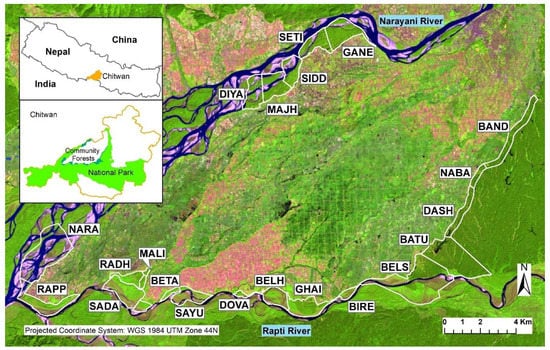
Figure 1.
False-color Landsat 8 three-band composite of the study area. White polygons depict the community forest boundaries, with forest codes illustrated. Image acquisition date: Oct. 27, 2014. Red: Band 6 (1560–1660 nm); green: Band 5 (845–885 nm); blue: Band 4 (630–680 nm).
Most of the community forests in this study were established along the Narayani and Rapti Rivers, where riverine mixed forests are the dominant vegetation types, supplemented by riparian grasslands. The most common species in these riverine forests include Acacia catechu, Bombax cieba, Dalbergia sissoo, Maesa chisia, Melia azedarach and Trewia nudiflor. The four inland forests (BAND, NABA, DASH and BATU), however, are dominant by Sal trees (Shorea robusta). The study area has a tropical monsoon climate, with most of the yearly precipitation falling between June and September. According to nearby meteorological stations, the average daily temperature in the study area ranges from 36 °C in the summer to 18 °C in January. Based on their vegetation types and geographical locations, we divided these 21 forests into five groups (Table 1).

Table 1.
Community forests in the study area.
2.2. Data
Due to the timespan of the research objective (dating back to the 1980s), we utilized Landsat imagery (Path/Row: 142/41) and searched in USGS EarthExplorer (https://earthexplorer.usgs.gov/) for potential Landsat surface reflectance products (level 2; TM, ETM+ and OLI). Searching criteria included that 1) image acquisition dates are within a two-month window after monsoon (approximately between late September and mid-November) to account for peak-biomass conditions and 2) images are cloud-free above the study area. If multiple images met the above two criteria, the earliest available was selected. Consequently, we were able to identify at least one image for most of the years (Table 2).

Table 2.
Landsat imagery and their calendar and Julian dates.
2.3. Methods
One of the challenges in quantifying vegetation cover in our study area was the water body dynamics in the community forests. The Narayani and Rapti Rivers flew sinuously across most riverine forests (Figure 1). Further, annual monsoon and the consequent rainfall could submerge large portions of the riverine forests, especially the riparian grasslands, altering water body boundaries frequently. Before examining vegetation cover, we first examined the water fraction dynamics and developed water masks for all forests. We then applied spectral mixture analysis to selected Landsat imagery and analyzed the green vegetation fractions of green vegetation (GV), non-photosynthetic vegetation and soil. We also calculated the normalized difference fraction index (NDFI; []) to evaluate forest canopy gaps. Both GV fractions and NDFI were adjusted to minimize the effects of water bodies at the forest level. We compared the GV fractions and NDFI values from different time periods to examine the green-up signals. Figure 2 illustrates the flow of image processing procedures, whereas detailed descriptions are presented in the following paragraphs.
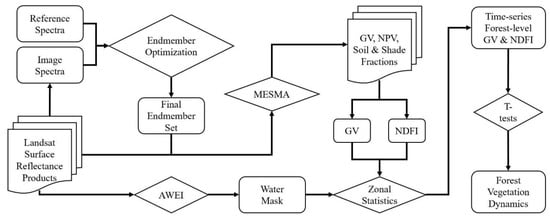
Figure 2.
Flow of image processing and analysis procedures. MESMA: multiple endmember spectral mixture analysis; GV: green vegetation; NPV: non-photosynthetic vegetation; NDFI: normalized difference fraction index; AWEI: automatic water extraction index.
2.3.1. Water Mask
To develop water masks, we utilized the automatic water extraction index (AWEInsh; []) to map surface water in the study area:
where Green, SWIR (short-wave infrared) 1, NIR (near infrared) and SWIR2 are the reflectance values of corresponding bands (Table 3). Based on visual interpretation, an AWEInsh threshold of 0.1 was used to generate water masks and dichotomize all images into water and non-water regions, where pixels with AWEInsh value higher than 0.1 were assigned to water.

Table 3.
Landsat bands used in AWEInsh.
2.3.2. Spectral Mixture Analysis
Spectral mixture analysis (SMA) is a classic method quantifying spectrally mixed pixels, especially for moderate and coarse spatial resolution imagery. SMA assumes that an image pixel’s spectral reflectance can be modeled as the weighted addition of the reflectance of pure materials, or endmembers, within that pixel [,]. Developed upon simple SMA, multiple endmember SMA (MESMA) allows the type and number of endmembers to vary on a per-pixel basis, accounting for potential endmember varieties []. In this study, we applied MESMA to the selected Landsat imagery.
For most vegetated landscapes, the image pixels can usually be modeled as a green vegetation (GV), non-photosynthetic vegetation (NPV), soil and shade mixture. To apply MESMA, we utilized and adopted the methodology and MESMA fractions generated in Dai et al. []. We first developed and optimized a spectral library from both reference and image spectra sources. Reference spectra were collected from both online spectral libraries and field measurements in the study area, and they were convolved to relative sensor wavelengths (e.g., TM, ETM, and OLI). Image spectra were extracted from the Landsat imagery to be analyzed. For each sensor type, we developed a spectral library and optimized endmember sets. We then used the optimized endmember sets to unmix selected Landsat images. We obtained fine spatial resolution imagery (reference image) to perform fraction validation for MESMA results. We selected random points (validation pixels; N = 100) from overlapped area between the study area and the reference image and plotted MESMA fractions against reference fractions. For all bright endmember types (GV, NPV and soil), the R2 values were above 0.9, which indicated good MESMA results. We refer to Dai et al. [] for more technical details.
MESMA generated fractional layers for each bright endmember (GV, NPV and soil) as well as shade. At the pixel level, we shade normalized the green vegetation fractions:
where GV and shade are the fractions generated in MESMA. Next, the average green vegetation fraction of each community forest, GVzonal, was processed through zonal statistics (mean). We applied the water mask generated in Section 2.3.1 and only non-water pixels were included in the calculation.
2.3.3. Normalized Difference Fraction Index
The normalized difference fraction index (NDFI; []) accentuates the degradation signals for it combines multiple impacts of forest degradation, including an increase in NPV and increase in bare soil. In addition to MESMA generated green vegetation fractions, we also calculated NDFI of the forests to examine and sharpen the signals of canopy damage and gaps:
where GVshade is the shade normalized GV fraction calculated in Equation (2); NPV and soil are the fractions generated in MESMA. In the end, forest-level average NDFI values, NDFIzonal, were calculated through zonal statistics (mean) analyzes. Identical to the processing in Section 2.3.2, we applied the water masks and only non-water pixels were included in the calculation.
2.3.4. Forest Dynamics
Although we selected Landsat imagery from approximately similar times of the year to account for peak-biomass vegetation conditions, the Julian dates of image acquisitions still differ considerably (Table 2), which can lead to fluctuations in vegetation dynamics. Instead of conducting a yearly-based time series analysis and because of some limited imagery availability, we divided the 1988–2018 timespan into four periods to analyze forest dynamics (Table 4). Period I accounted for forest conditions before the establishment of community forests in 1993, and Periods II, III and IV were related to post-establishment conditions. For each period, Landsat images from multiple years were selected so that the average Julian dates were similar among different periods. To identify potential significant changes between any two periods, forest-level average GVshade and NDFI values (from Section 2.3.2 and Section 2.3.3) of each period were compared through one-tailed two sample unequal variance t-tests (e.g., Periods I vs. II, II vs. III, III vs. IV, I vs. III, II vs. IV and I vs. IV), where all values in the same period were treated as a sample. Comparisons between Period I and all later periods (I vs. II–IV) were also conducted to evaluate the potential effects of the 1993 Community Forestry Act on forest dynamics.

Table 4.
Selected Landsat imagery for different periods.
3. Results
3.1. MESMA Results
Land cover in the forests changed dramatically in the past three decades, with green vegetation area increased substantially in most of the forests (Figure 3). Here we select one year’s image from each period with close to identical Julian dates and present their MESMA results. Red pixels indicate NPV and were usually related to forest degradation. The quantitative analyses of the green vegetation fractions and the significance of change will be discussed in the following paragraphs.
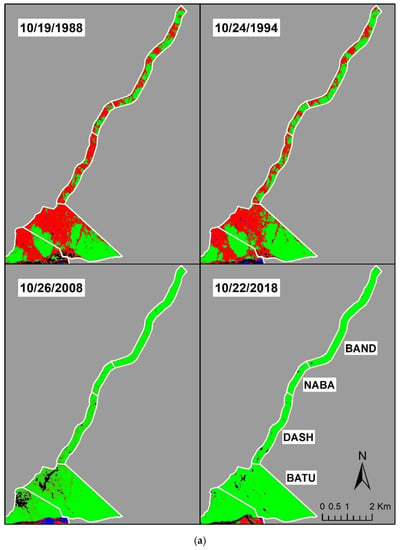
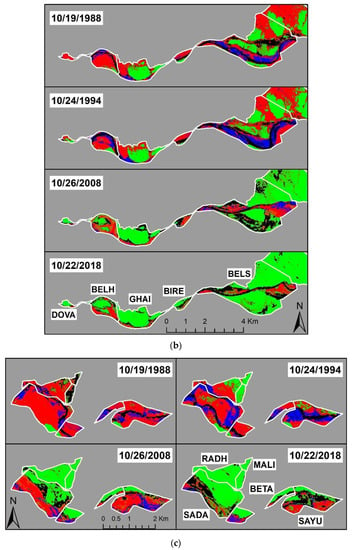
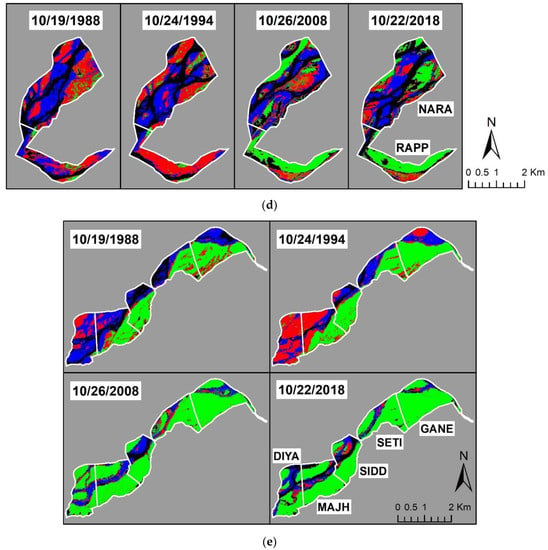
Figure 3.
False-color composite images of shade-normalized MESMA results in (a) East Sal, (b) South Centra Rapti, (c) South West Rapti, (d) Far West and (e) North Narayani forests for selected years. Red: NPV; green: GV; blue: soil; black: unmodeled (water, wetland, etc.).
The average green vegetation cover across all forests increased from approximately 30% in 1988 to above 70% in 2018 (Figure 4). The four East Sal forests had minimal disturbances from flooding or river channel changes and had the highest green vegetation fractions among all forests (Figure 4 and Table 5). Especially for recent years, the green vegetation fractions were all approximately or above 0.95. MALI in the South West Rapti group and GANE in the North Narayani group also had relatively high average green vegetation fractions for the past three decades (0.74 and 0.68, respectively). Highly disturbed by the river flows, SAYU from the South West Rapti group and NARA from the Far West group had the lowest average green vegetation fractions (0.20 and 0.21, respectively) among all forests.
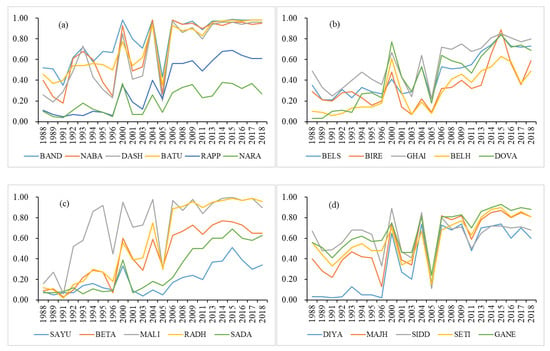
Figure 4.
Green vegetation fractions of (a) East Sal and Far West, (b) South Central Rapti, (c) South West Rapti and (d) North Narayani community forests from 1988 to 2018.

Table 5.
Average green vegetation fraction of each forest from 1988 to 2018.
As predicted in Section 2.3.4, we detected fluctuations in the curves of green vegetation fractions, potentially due to the prominent differences in imagery Julian dates. Despite occasional spikes and valleys largely, the general trends of the green vegetation fraction curves were ascending.
Comparisons among different periods indicate the trends of change in green vegetation fractions in the forests (Table 6). Only one significant change (BIRE between Periods I and II) showed a decrease in green vegetation fractions, whereas all other changes showed increases. Five forests (BELH, DOVA, MALI, RADH and GANE) rapidly greened up after the establishment of the community forests in the 1990s (Period I vs. Period II). Comparing Period I (before the 1993 Community Forestry Act) with Period IV (2010s), all forests showed significant increases in green vegetation fractions. Combining all values after 1993 into a single dataset (Period II~IV) and comparing them with Period I, the null hypothesis (later period has no higher values than the previous period) could not be rejected for only two forests (BIRE and SIDD). The green-up signals were highly correlated with the establishment of the community forests.

Table 6.
Comparison of green vegetation fractions among different periods. Only significant p values (<5 × 10−2) are listed. Italic numbers (BIRE, I vs. II) indicate decreases. All others indicate increases.
3.2. Normalized Difference Fraction Index
In the community forests, the general patterns of NDFI were similar to those of green vegetation fractions (Figure 5 and Table 7). The four East Sal forests, plus MALI and GANE, had relatively high average NDFI values (0.43~0.67). The NDFI values of NARA and SAYU (-0.54 and -0.43, respectively) were lower than other forests. Similar to green vegetation fractions, spikes and valleys in NDFI curves may be introduced by imagery capture dates. Nevertheless, the general trends of NDFI curves are generally ascending.
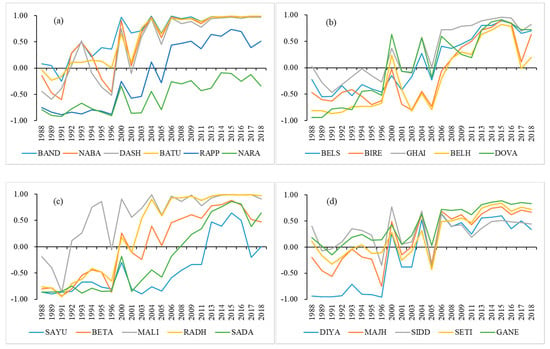
Figure 5.
NDFI of (a) East Sal and Far West, (b) South Central Rapti, (c) South West Rapti and (d) North Narayani community forests from 1988 to 2018.

Table 7.
Average NDFI of each forest from 1988 to 2018.
The change patterns of NDFI for all community forests were similar to those of green vegetation fractions (Table 8), only no significant decreases were detected. Three forests (BELH, DOVA and RADH) showed rapid greening up after the establishment of community forests (Period I vs. Period II). All comparisons between Periods I and IV indicated significant increases. Except for SIDD, all other comparisons between Period I and Periods II~IV showed prominent green-up signals.

Table 8.
Comparison of NDFI among different periods. Only significant p values (<5 × 10−2) are shown. All values indicate increase in NDFI.
4. Discussion
Situated in the frontier of human–environment interactions, the western Chitwan community forests provide desirable opportunities to study how human and endangered large carnivores and ungulates can coexist at fine spatial scales []. The vegetation conditions of these forests are vital to both the survival of the endangered species and the livelihoods of local residents. To date, however, there have been no systematic assessments of these forests for the past three decades. In our research, we adopted two indicators (green vegetation fraction from MESMA and NDFI) to evaluate the vegetation dynamics in these forests. The average green vegetation cover of these forests has been increasing since their establishment, from approximately 30% in 1988 to above 70% in 2018. This green-up trend was also discovered for community forests both locally in Nepal [,], and in other regions of the world [,].
Although the green vegetation fractions and NDFI values have been increasing during the 30 years, and the values for post-1993 imagery were significantly higher than that of the pre-1993 imagery, factors other than the community forest management may also have affected the green-up signals in the study area. Since the late 1990s, a notorious exotic plant, Mikania micrantha, nicknamed “mile-a-minute-vine”, has been invading the Chitwan National Park and its buffer zone []. The invasion was most prominent in the riparian habitats, affecting all riverine community forests in this study []. As an understory creeping vine, M. micrantha tends to fill the gaps between forest canopies and increase green vegetation fractions in the forest image pixels. In other words, in addition to reforestation, the invasion may also have contributed to the green-up signals we quantified in this research.
It should be noted that it is not the ultimate objective of this research to articulate the relative contributions to the green-up signals. Nevertheless, from the most conservative perspective, we can at least be sure that in the East Sal forests where invasion has been minimal [], community forestry management and reforestation has been the prime cause for green up. Further, in the five forests (BELH, DOVA, MALI, RADH and GANE) where green vegetation fractions significantly increased in the years right after 1993, the contribution of reforestation appears to be the main reason for green up, since the invasion of M. micrantha was minimal back then [].
5. Conclusions
We evaluated the green vegetation dynamics in western Chitwan community forests, Nepal from 1988 to 2018. With the potential influences from water minimized, the comparison of forest-level green vegetation fractions from spectral mixture analysis and a forest degradation index (NDFI), based on two-sample unequal variance t-tests showed that the forests have been continually greened up during those thirty years. Although the invasion of an understory vine may have partially contributed to the changes in some forests in recent years, the establishment of community forests and the resultant forest management should be credited for some of the green-up signals, especially in the inland Sal forests. Future work may be conducted to quantify and separate the relative contributions of exotic plant invasion and community forest management practices, especially in the riverine forests where invasion has been most prominent.
Author Contributions
Conceptualization, J.D., D.A.R., D.A.S., L.A., and Q.Z.; methodology, J.D.; formal analysis, J.D.; writing—original draft preparation, J.D.; writing—review and editing, J.D., D.A.R., D.A.S., L.A., and Q.Z.; funding acquisition, J.D., and L.A. All authors have read and agreed to the published version of the manuscript.
Funding
This research was funded by the U.S. National Science Foundation under the Dynamics of Coupled Natural and Human Systems program (grant BCS-1211498) and the National Aeronautics and Space Administration Earth and Space Science Fellowship (grant 80NSSC17K0317).
Acknowledgments
We are grateful to Malvern Panalytical for providing the FieldSpec® 4 Standard-Res spectroradiometer through the Goetz Student Support Program. We also thank the Inamori Fellowship, the William & Vivian Finch Fellowship, the Institute for Social and Environmental Research—Nepal, and San Diego State University for financial and research support. Qunshan Zhao has received UK ESRC’s on-going support for the Urban Big Data Centre (UBDC) [ES/L011921/1 and ES/S007105/1].
Conflicts of Interest
The authors declare no conflict of interest.
References
- Gilmour, D. Forty Years of Community-Based Forestry: A Review of Its Extent and Effectiveness; FAO: Rome, Italy, 2016. [Google Scholar]
- Sikor, T.; Gritten, D.; Atkinson, J.; Huy, B.; Ram Dahal, G.; Duangsathaporn, K.; Hurahura, F.; Phanvilay, K.; Maryudi, A.; Pulhin, J.; et al. Community Forestry in Asia and the Pacific: Pathway to Inclusive Development; RECOFTC: Bangkok, Thailand, 2013. [Google Scholar]
- Coppin, P.R.; Bauer, M.E. Digital change detection in forest ecosystems with remote sensing imagery. Remote Sens. Rev. 1996, 13, 207–234. [Google Scholar] [CrossRef]
- Potapov, P.; Yaroshenko, A.; Turubanova, S.; Dubinin, M.; Laestadius, L.; Thies, C.; Aksenov, D.; Egorov, A.; Yesipova, Y.; Glushkov, I.; et al. Mapping the world’s intact forest landscapes by remote sensing. Ecol. Soc. 2008, 13, 51. [Google Scholar] [CrossRef]
- Kim, D.-H.; Sexton, J.O.; Noojipady, P.; Huang, C.; Anand, A.; Channan, S.; Feng, M.; Townshend, J.R. Global Landsat-Based forest-cover change from 1990 to 2000. Remote Sens. Environ. 2014, 155, 178–193. [Google Scholar] [CrossRef]
- Rouse, J.W.; Hass, R.H.; Schell, J.A.; Deering, D.W. Monitoring vegetation systems in the Great Plains with ERTS. In Proceedings of the Third ERTS Symposium 1973, Washington, DC, USA, 10–14 December 1973; Freden, S.C., Mercanti, E.P., Becker, M.A., Eds.; pp. 309–317. [Google Scholar]
- Huete, A.R. A Soil-Adjusted Vegetation Index (SAVI). Remote Sens. Environ. 1988, 25, 295–309. [Google Scholar] [CrossRef]
- Qi, J.; Chehbouni, A.; Huete, A.R.; Kerr, Y.H.; Sorooshian, S. A modified soil adjusted vegetation index. Remote Sens. Environ. 1994, 48, 119. [Google Scholar] [CrossRef]
- Liu, H.; Huete, A. A feedback based modification of the NDVI to minimize canopy background and atmospheric noise. IEEE Trans. Geosci. Remote Sens. 1995, 33, 457–465. [Google Scholar] [CrossRef]
- Saleska, S.R.; Didan, K.; Huete, A.R.; da Rocha, H.R. Amazon forests green-up during 2005 drought. Science 2007, 318, 612. [Google Scholar] [CrossRef]
- Samanta, A.; Ganguly, S.; Hashimoto, H.; Devadiga, S.; Vermote, E.; Knyazikhin, Y.; Nemani, R.R.; Myneni, R.B. Amazon forests did not green-up during the 2005 drought. Geophys. Res. Lett. 2010, 37, L05401. [Google Scholar] [CrossRef]
- Zhang, G.; Zhang, Y.; Dong, J.; Xiao, X. Green-up dates in the Tibetan Plateau have continuously advanced from 1982 to 2011. PNAS 2013, 110, 4309–4314. [Google Scholar] [CrossRef]
- Shen, M.; Sun, Z.; Wang, S.; Zhang, G.; Kong, W.; Chen, A.; Piao, S. No evidence of continuously advanced green-up dates in the Tibetan Plateau over the last decade. PNAS 2013, 110, E2329. [Google Scholar] [CrossRef]
- Adams, J.B.; Sabol, D.E.; Kapos, V.; Filho, R.A.; Roberts, D.A.; Smith, M.O.; Gillespie, A.R. Classification of multispectral images based on fractions of endmembers: Application to land-cover change in the Brazilian Amazon. Remote Sens. Environ. 1995, 52, 137–154. [Google Scholar] [CrossRef]
- Roberts, D.; Gardner, M.; Church, R.; Ustin, S.; Scheer, G.; Green, R. Mapping chaparral in the Santa Monica Mountains using multiple endmember spectral mixture models. Remote Sens. Environ. 1998, 65, 267–279. [Google Scholar] [CrossRef]
- Souza, C.M., Jr.; Roberts, D.A.; Cochrane, M.A. Combining spectral and spatial information to map canopy damage from selective logging and forest fires. Remote Sens. Environ. 2005, 98, 329–343. [Google Scholar] [CrossRef]
- Souza, C.M., Jr.; Siqueira, J.V.; Sales, M.H.; Fonseca, A.V.; RIberio, J.G.; Numata, I.; Cocharane, M.A.; Barber, C.P.; Roberts, D.A.; Barlow, J. Ten-year Landsat classification of deforestation and forest degradation in the Brazilian Amazon. Remote Sens. 2013, 5, 5493–5513. [Google Scholar] [CrossRef]
- Nagendra, H. Tenure and forest conditions: Community forestry in the Nepal Terai. Environ. Conserv. 2002, 29, 530–539. [Google Scholar] [CrossRef]
- Murphy, S.T.; Subedi, N.; Jnawali, S.R.; Lamichhane, B.R.; Upadhyay, G.P.; Kock, R.; Amin, R. Invasive mikania in Chitwan National Park, Nepal: The threat to the greater one-horned rhinoceros Rhinoceros unicornis and factors driving the invasion. Oryx 2013, 47, 361–368. [Google Scholar] [CrossRef]
- Ministry of Forest and Soil Conservation (MFSC). Persistence and Change: Review of 30 Years of Community Forestry in Nepal; Government of Nepal: Kathmandu, Nepal, 2013.
- Acharya, K.P. Twenty-four years of community forestry in Nepal. Int. For. Rev. 2014, 4, 149–156. [Google Scholar] [CrossRef]
- Mbaabu, P.R.; Hussin, Y.A.; Weir, M.; Gilani, H. Quantification of carbon stock to understand two different forest management regimes in Kayar Khola watershed, Chitwan, Nepal. J. Indian Soc. Remote Sens. 2014, 42, 745–754. [Google Scholar] [CrossRef]
- Dhakal, R.R.; Kafle, G.; Yadava, J.N. Comparative assessment of floristic diversity in a buffer zone community forest and a community forest of Barandabhar corridor, Chitwan, Nepal. J. Hortic. For. 2011, 3, 244–250. [Google Scholar]
- United Nations Educational, Scientific and Cultural Organization (UNESCO). World Heritage List. Available online: http://whc.unesco.org/en/list/284 (accessed on 1 December 2020).
- Critical Ecosystem Partnership Fund (CEPF). Available online: http://www.cepf.net/our-work/biodiversity-hotspots/Himalaya (accessed on 1 December 2020).
- Spiteri, A.; Nepal, S. Distributing conservation incentives in the buffer zone of Chitwan National Park, Nepal. Environ. Conserv. 2008, 35, 76–86. [Google Scholar] [CrossRef]
- Feyisa, G.L.; Meilby, H.; Fensholt, R.; Proud, S.R. Automated Water Extraction Index: A new technique for surface water mapping using Landsat imagery. Remote Sens. Environ. 2014, 140, 23–35. [Google Scholar] [CrossRef]
- Dai, J.; Roberts, D.A.; Stow, D.A.; An, L.; Hall, S.J.; Yabiku, S.T.; Kyriakidis, P.C. Mapping understory invasive plant species with field and remotely sensed data in Chitwan, Nepal. Remote Sens. Environ. 2020, 250, 112037. [Google Scholar] [CrossRef]
- Carter, N.H.; Shrestha, B.K.; Karki, J.B.; Pradhan, N.M.B.; Liu, J. Coexistence between wildlife and humans at fine spatial scales. PNAS 2012, 109, 15360–15365. [Google Scholar] [CrossRef] [PubMed]
- Niraula, R.R.; Gilani, H.; Pokharel, B.K.; Qamer, F.M. Measuring impacts of community forestry program through repeat photography and satellite remote sensing in the Dolakha district of Nepal. J. Environ. Manag. 2013, 126, 20–29. [Google Scholar] [CrossRef] [PubMed]
- Tripathi, S.; Subedi, R.; Adhikari, H. Forest Cover Change Pattern after the Intervention of Community Forestry Management System in the Mid-Hill of Nepal: A Case Study. Remote Sens. 2020, 12, 2756. [Google Scholar] [CrossRef]
- Poffenberger, M. People in the forest: Community forestry experiences from Southeast Asia. Int. J. Environ. Sustain. Dev. 2006, 5, 57–69. [Google Scholar] [CrossRef]
- Newton, P.; Schaap, B.; Fournier, M.; Cornwall, M.; Rosenbach, D.W.; DeBoer, J.; Whittemore, J.; Stock, R.; Yoders, M.; Brodnig, G.; et al. Community forest management and REDD+. For. Policy Econ. 2015, 56, 27–37. [Google Scholar] [CrossRef]
Publisher’s Note: MDPI stays neutral with regard to jurisdictional claims in published maps and institutional affiliations |
© 2020 by the authors. Licensee MDPI, Basel, Switzerland. This article is an open access article distributed under the terms and conditions of the Creative Commons Attribution (CC BY) license (http://creativecommons.org/licenses/by/4.0/).